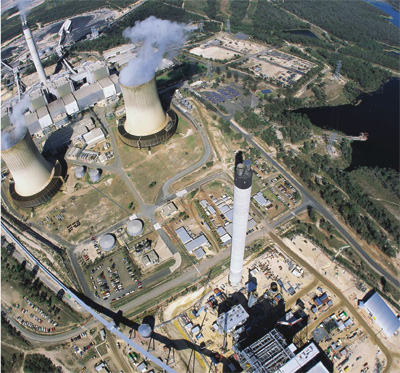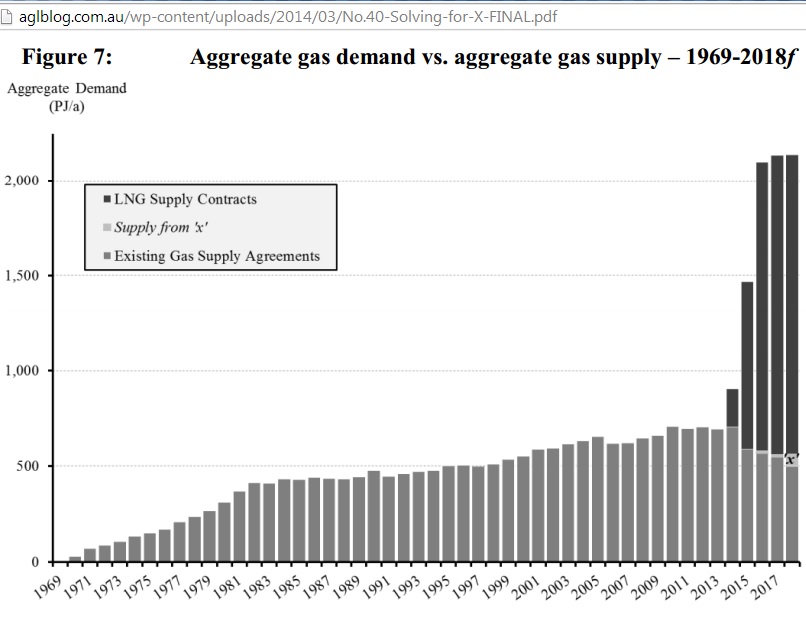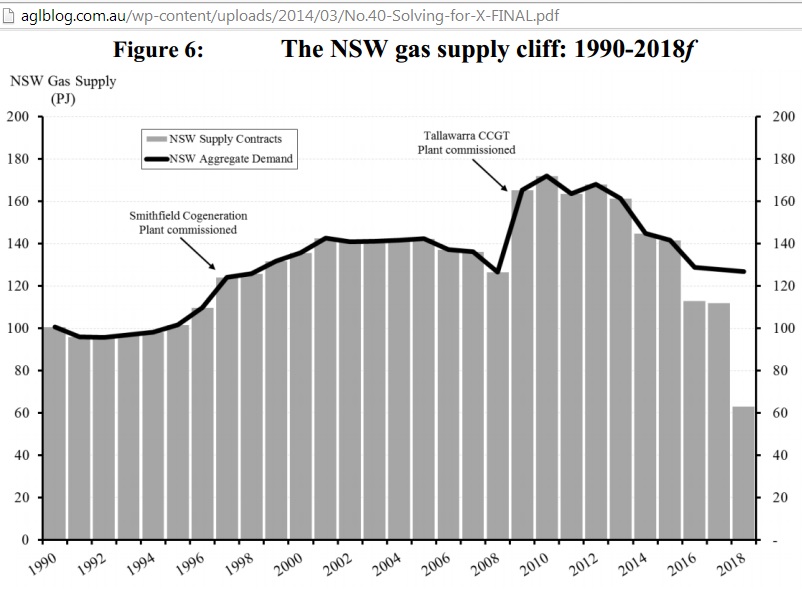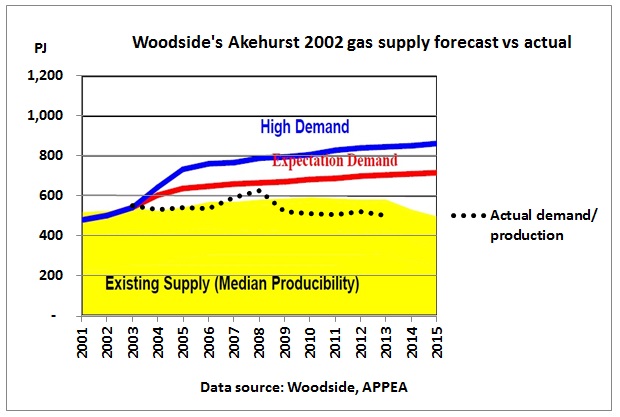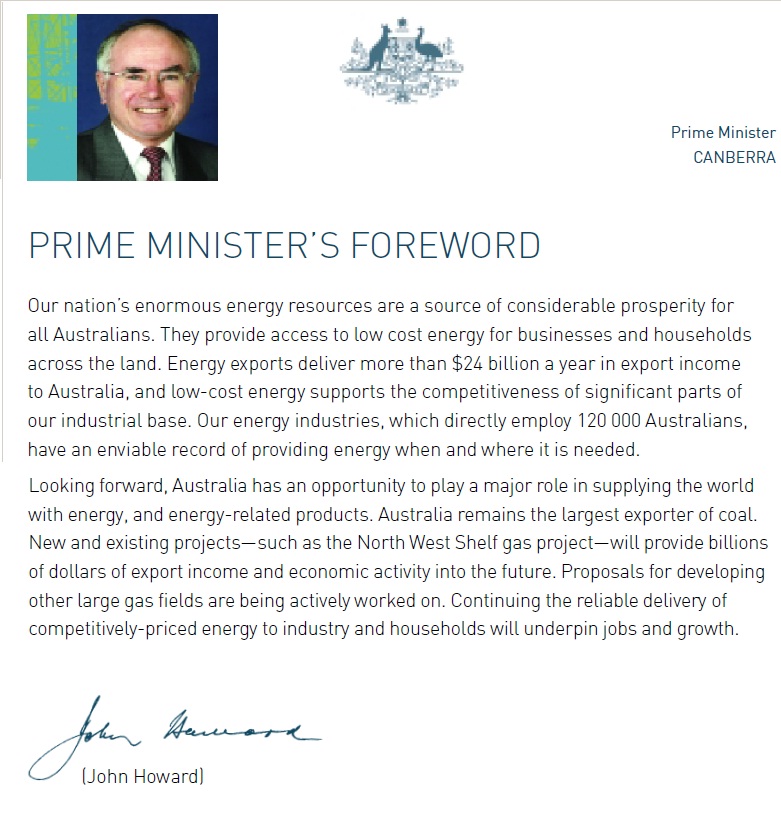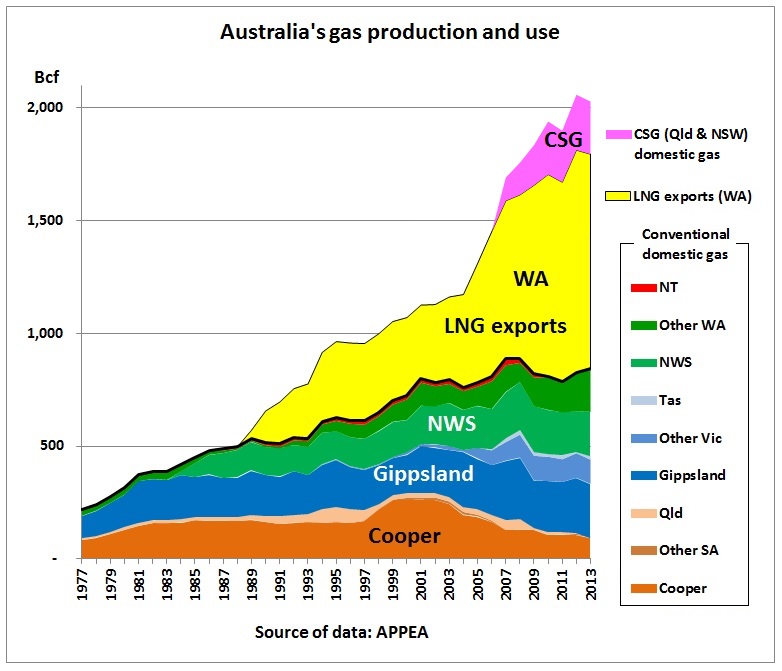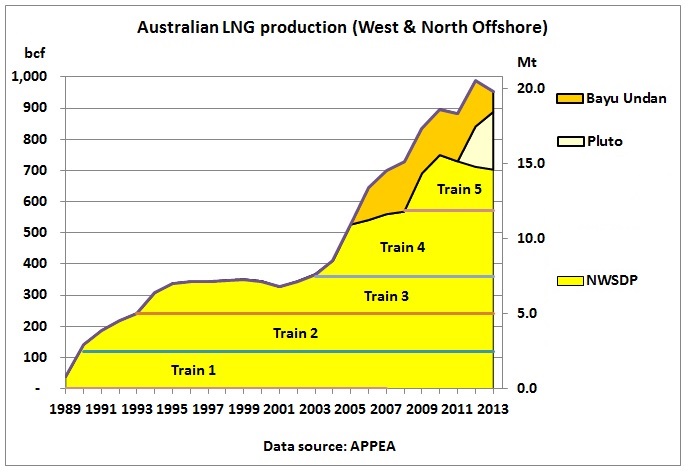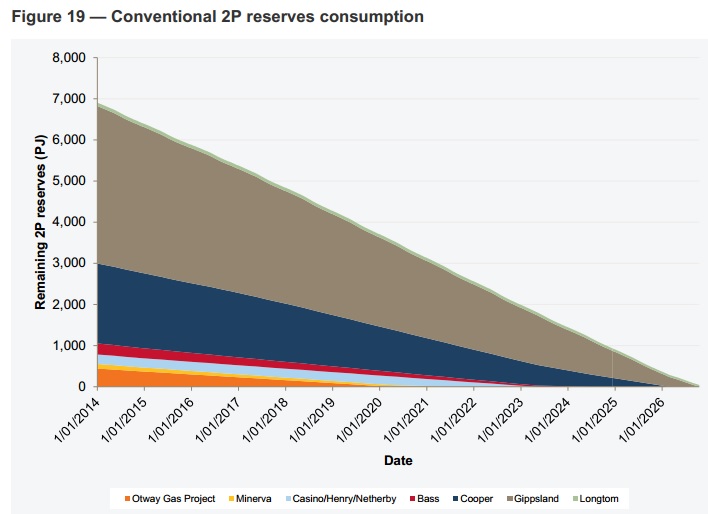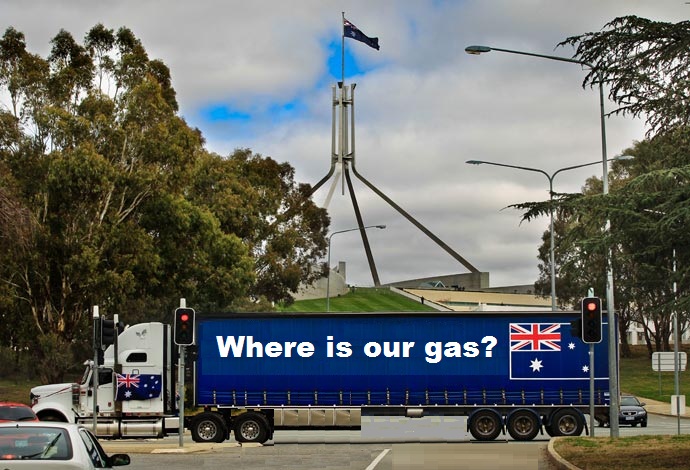In July 2006 then Prime Minister Howard declared Australia an energy super power. 2 years earlier his energy white paper set the framework for unlimited gas exports while neglecting to set aside gas for domestic use. It is a bitter irony that at the 10th anniversary of this energy white paper we read that gas shortages in the Eastern market will result in price increases and that there is not even enough cheap gas for gas fired power plants which are supposed to replace dirty coal fired plants or serve as a back-up for renewable power. Wrong decisions a decade ago (or even earlier) now come to the attention of the public as price rises hit the pockets of consumers.
And what has been completely forgotten is that natural gas is the only alternative transport fuel to replace oil. Conventional oil peaked in 2006 (Yes, Prime Minister, under your watch), US shale oil is likely to peak before 2020 and the Middle East is disintegrating in front of our TV eyes faster than energy and transport planners can change their perpetual-growth mindset. An energy equivalent of 5 LNG trains is needed to replace all oil based fuels in Australia. This gas is locked away in long term export contracts. Well done. Les jeux sont faits.
(1) Recent events
Electricity providers return to coal-fired power as natural gas export revenue soars
3/7/2014
The rising international price of natural gas is causing electricity providers to return to coal-fired power, with Queensland among the first to make the move.
Fig 1: Tarong power station in Queensland
University of Queensland energy analyst Dr Liam Wagner says the rising price will push other power companies to make similar decisions.
“Gas-fired electricity is becoming more expensive; gas in Australia is going to become more expensive with exports,” he said.
“In the future we’re going to have less gas because it’ll be far more expensive to burn it here and the gas producers will be able to make more money overseas.”
http://www.abc.net.au/news/2014-07-03/electricity-providers-return-to-coal-fired-power-as-natural-gas/5567252
Nation will be paying the bill for poor energy policy
30/6/2014
The government, unlike other governments around the world, allowed unfettered access to global markets. The building of the export gas terminals will push the prices for gas inexorably up towards world prices. Indeed, wholesale gas prices are widely forecast to more than double to match international prices.
Many in the gas industry are calling for the rapid development of environmentally suspect coal seam gas fields in NSW to counter higher prices. This policy simply will not work as prices on the East Coast are now linked to world prices. No amount of domestic production will change this dynamic.
http://www.smh.com.au/comment/electricity-and-gas-prices-why-youre-paying-more-20140629-zspp1.html
As we can see in the following report, AGL is proud to have connected the domestic market to the Asian market to make quick profits, instead of developing a plan which would use gas domestically in the medium and long-term to maximise economic benefits for the local industry. The quarry mentality continues. The expected shortages are presented as an argument for even more coal seam gas.
AGL raises spectre of gas rationing if gas shortages are not tackled, it tells the NSW Government
17/3/2014
Gas shortages will lead to rationing along with job losses, especially in Sydney’s west, energy utility AGL has warned as it intensifies pressure on the NSW government to allow the development of gas projects in the state that tap gas trapped in coal seams.
http://www.smh.com.au/business/agl-raises-spectre-of-gas-rationing-if-gas-shortages-are-not-tackled-it-tells-the-nsw-government-20140316-34vgr.html
This is the report:
AGL Applied Economic and Policy Research
Solving for ‘x’ – the New South Wales Gas Supply Cliff
March 2014
“During this discovery and appraisal phase, it was evidently clear to resource owners that the east coast gas market was not sufficiently large enough to enable the monetisation of reserves in suitable timeframes and at the scale necessary to maximise profit, and so developing an export market for natural gas in the form of LNG was a logical strategic solution. Not only would it result in the rapid expansion of aggregate demand, but would also have the benefit of linking domestic gas prices, historically ca $3 per gigajoule (/GJ), to the north Asian export market price of ca $6-9/GJ equivalent ex-field ‘netback price’ over the medium term” (p 2)
“On Australia’s east coast over the period 2013-2016, we forecast that aggregate demand for natural gas will increase three-fold, from 700 PJ to 2,100 PJ per annum, while our forecast of system coincident peak demand increases 2.4 times, from 2,790 TJ to 6,690 TJ per day. This extraordinary growth is being driven by the development of three Liquefied Natural Gas plants at Gladstone, Queensland”. (p 1)
“Almost simultaneously, a non-trivial quantity of existing domestic gas contracts currently supplying NSW will mature. Much of that gas has been recontracted to LNG producers in Queensland – thus creating a gas supply cliff in NSW. Compounding matters, recent policy developments have placed binding constraints over the development of new gas supplies in NSW”(p 1)
Fig 3: NSW gas supply cliff lead to price increases
http://aglblog.com.au/wp-content/uploads/2014/03/No.40-Solving-for-X-FINAL.pdf
These developments are a bitter irony given that the public has been told many times that Australia’s gas resources are abundant. All LNG export contracts were presented as great achievements.
(2) Wrong decisions 12 years ago
Although LNG exports to Japan had started in 1989 (20 years contracts with 8 power and utility companies signed in 1985), the 2002 LNG deal with China was Howard’s first main contribution towards a poor energy policy.
Australia Wins China LNG Contract
8/8/2002
John Howard: “I am delighted to announce that today I have been advised by the Chinese Premier Zhu Rongji that Australia’s Northwest Shelf Venture has been chosen by China to be the sole supplier of liquefied natural gas (LNG) to its first LNG project in Guangdong province.”
http://australianpolitics.com/news/2002/08/02-08-08.shtml
5 months earlier, John Akehurst, Woodside’s Managing Director, warned in a report with mixed messages:
Mar 2002
Challenges for Australia
Australia has large gas reserves which have the potential to meet a much larger proportion of Australia’s energy requirements, including liquid petroleum requirements (via CNG, LNG, Gas to Liquids). Gas for oil substitution would deliver significant greenhouse benefits and help Australia meet its Kyoto target. Increased LNG exports would partly offset the cost of rising liquids imports and help address their impact on the balance of payments. (p 8 )
However, greater use of gas will require substantially more investment in gas production and pipeline infrastructure. Without such investment, south eastern Australian gas markets will, within a few years, face possible gas shortages. Major consumers will find it more difficult to secure long term supply contracts on sufficiently competitive terms (p 9)
Fig 4: Superimposition Akehurst forecast with actual production
LNG export projects and gas-based value adding projects are needed to underpin the cost of bringing new gas supply sources to shore and to justify the initial investment. These types of projects compete on world markets (primarily with projects in Asia) and the provision of an internationally competitive investment environment including fiscal terms is a key driver. (p 10)
www.aspo-australia.org.au/References/Akehurst%20ABARE%202002.pdf
Of course one cannot have it both ways. To replace petrol and diesel in Australia one would need the energy equivalent of 5 LNG trains.
(3) Howard’s flawed Energy White Paper June 2004
Fig 5: excerpt from Howard’s June 2004 energy white paper
This white paper just rationalises decisions already made earlier by formulating following policy principles (p 53)
- Commercial decisions should determine the nature and timing of energy resource developments, with government interventions being transparent and allowing commercial interests to seek least-cost solutions to government objectives (e.g. environment, safety or good resource management objectives).
- Government objectives should generally be driven by sector-wide policy mechanisms rather than impose inconsistent requirements on individual projects/private investors.
And on page 128:
“Australia’s gas reserves are sufficient for more than 100 years at current production levels, or more than 200 years of current domestic consumption. Furthermore, prospects for finding and proving up more gas are good, subject to finding markets. However, the location of Australia’s major gas reserves—to the north and north-west —compared with major demand locations—to the south-east—is sometimes raised as an issue (see Figure 6 and 3 in Chapter 2—Developing Australia’s Energy Resources).”
Note the term “At current production levels” which of course is irrelevant when LNG exports are doubled or tripled.
Fig 6: Map of oil and gas resources in the EWP 2004
Fig 7: Map of gas pipelines in EWP 2004
The Geoscience Report “Oil and Gas Resources in Australia 2004 writes: “Natural gas has a current “life” estimated at 65 years, but past estimates have been as low as 39 years (in 1993) and as high as 76 years (in 2001). These estimates include all resources and production in the JPDA with Timor-Leste.”
Fig 8: Geoscience Australia’s reserve to production ratios
http://www.ga.gov.au/image_cache/GA8550.pdf
The EWP 2004 continues to argue:
“Predictions are made that supplies of gas to major urban markets will run short in the next decade, as production in the Cooper Basin and Bass Strait declines. This has resulted in calls for financial support towards the building of major pipelines from either the Northern Territory (to access gas from Sunrise and other Timor Sea fields), Papua New Guinea or north-west Australia (to access gas from either Carnarvon or Browse Basins). While reserves of gas in existing fields close to southeast markets are declining, this does not represent an energy security concern.
Exploration is occurring in the south-east and is resulting in new discoveries and development, such as in the Otway Basin. The development of coal seam methane is also increasing supplies of gas in the region. In addition, holders of the large remotely located gas reserves are actively seeking markets to monetise these reserves. These efforts include actively investigating pipeline projects for bringing supplies of gas from north and north-west sources, as well as seeking LNG export sales in Asian markets. The number and activity of these competing proposals provide a degree of confidence that these supplies will become available once economic, noting that this will in all likelihood occur at higher price levels than those currently enjoyed in some south-eastern markets.
Given the size and placement of gas reserves relative to current and future gas demand, gas supply is not likely to become an issue for the short to medium term. Pre-empting market outcomes in these circumstances is unlikely to add significantly to energy security, but could inflict significant costs by precluding less costly options (such as further development of the Gippsland and Otway basins or coal seam methane).”
http://www.efa.com.au/Library/CthEnergyWhitePaper.pdf
The task of building North/West-East gas pipelines was not pro-actively followed up by State and Federal governments but dropped altogether in favour of exports. No wonder this laissez-faire approach went wrong.
CO2 emissions
The EWP 2004 argues:
“The shape of future international action on climate change is unclear, but the potential costs of future adjustments and long life of energy assets makes it prudent to prepare for the future.” ( p 131)
LNG development could increase Australia’s energy emissions by around 1 per cent of energy sector emissions. However, to the extent that exported Australian gas replaces more greenhouse intensive energy in the importing country, global emissions may decrease as a result of Australian gas production (p 137)
This is just an argument in favour of LNG exports while none of the LNG contracts included a clause that coal fired power plants equivalent to the energy content of the gas should be decommissioned in the destination country. The above example of Queensland going back to coal shows that not even in Australia the job of using gas to reduce emissions is taken seriously.
(4) Energy super power declared in 2006
17/7/2006
The Prime Minister has outlined his vision for energy and water, saying the nation has the makings of an energy superpower.
http://www.abc.net.au/news/2006-07-17/howard-outlines-energy-superpower-vision/1803744
(5) Actual gas production
Let’s have a look at gas production statistics
Fig 9: Australia’s gas production 1977-2013
Data are from APPEA: http://www.appea.com.au/?attachment_id=5192
We see peak gas in the Cooper basin between 1999 and 2002 at around 260 bcf. Right at that peak, Howard failed to pursue building a gas pipeline to connect Western offshore gas with Eastern gas markets. While LNG exports on the West coast surged, the East coast remained on a bumpy production plateau. Western Australia has a 15% Domgas policy but also did not introduce gas as a transport fuel. As WA’s LNG gas goes out the window, Queensland and NSW are forced to go for environmentally questionable coal seam gas.
Fig 10: Australia’s LNG exports
The first 3 trains (2.5 mt pa each) mainly supply Japanese utilities, while the Guangdong contract (3.3 mt pa over 25 years) required train 4 (4.4 mt pa)
(6) Conventional gas depletion in NSW, Victoria and South Australia
The Australian Energy Market Operator (AEMO) estimates in its Gas Statement of Opportunities 2013 that current conventional 2P reserves would be depleted by the mid of the next decade.
Fig 10: Depletion of conventional gas reserves (2P) in the South East
“Under the modelled production-cost conditions, consumption of Denison Trough 2P reserves occurs first in 2019. Consumption of Otway Basin 2P reserves begins in 2020, and it is completely consumed by 2023. Bass and Cooper basin conventional 2P reserves are consumed in 2025. Gippsland 2P reserves are consumed in 2026. The 2P CSG reserves in Queensland are sufficient to supply demand until the end of the 20-year outlook period.”
Fig 11: Gas shortfalls in the South East
“Additional 3P reserves and 2C resources are available in the Otway, Bass, Gippsland, and Cooper basins. The 3P/2C reserves in the Bass, Gippsland, and Cooper basins are sufficient to ensure supply until the end of the 20-year outlook period, provided current transmission and production limitations remain unchanged. The 3P/2C reserves in the Otway Basin are only sufficient to ensure supply until 2028 or 2029, depending on the level of support the southern states receive from production in the north.
Given its role in supplying demand in Adelaide, Melbourne, and Sydney, the Otway Basin reserves consumption is a significant event, with substantial infrastructure investment required to manage changing system flows.”
http://www.aemo.com.au/Gas/Planning/Gas-Statement-of-Opportunities
(7) Domgas Alliance report
Australia Domestic Gas Policy Report (Nov 2012)
History has proven that countries with large resource endowment do not automatically gain an economic competitive advantage over countries that do not have such surplus endowment of resources. Exporting countries have to take the necessary precautions to avoid what are known to economists as the Natural Resource Curse and Dutch Disease. Australia’s large LNG export boom, that is well underway, has the capacity to trigger both of these symptoms and the subsequent regrets.
Gas resource rich countries rely on a comprehensive menu of interventions and gas regulations and policies in order to protect the national interest and the best interest of the general public regarding the use of indigenous gas production. Benchmarking illustrates that Australia does not manage its gas resources adequately to ensure that gas explorers and production companies operate in a manner that is consistent with a vibrant domestic gas market.
Gas resource rich countries, regions and continents generally export gas only after they first develop their own domestic gas market into a vibrant one that has very high gas consumption rates per capita and a high gas penetration in the total primary energy supply. To do otherwise destroys value and effectively de-industrialises the exporting region.
Australia needs to have sufficiently comprehensive policies and regulations in place in order to control and manage the export of raw commodities. Simply relying on market forces without comprehensive guidelines and controls to mitigate inequitable market power is one extreme while nationalising all resources is the other extreme. Neither of these scenarios has proven to serve the public interest very well.
(8) Gas price outlook
The following graph from the Eastern Australian Domestic Gas Market Study by BREE, Department of Industry, shows Energy Quest’s doubling of gas prices by the end of this decade.
Fig 12: Gas prices will double
Summary:
Decisions on excessive LNG exports have been made more than 10 years ago and are irreversible. They continued ever since – irrespective of which State or Federal governments were in power –and will lead to yet more LNG exports. Consumers will have to pay higher gas prices for having elected these governments. Another regret will come in the next years when it becomes clear that gas is needed as transport fuel.
Fig 13: Glimpse into the future: truckies protest drive around Canberra’s Capital Hill
Previous articles on this website on gas
9/5/2012 Queensland plans to export more than 10 times the gas NSW needs (part 3)
http://crudeoilpeak.info/queensland-plans-to-export-more-than-10-times-the-gas-nsw-needs-part-3
6/5/2012 Howard’s wrong decisions on offshore gas exports start to hit transport sector now
http://crudeoilpeak.info/howards-wrong-decisions-on-offshore-gas-exports-start-to-hit-transport-sector-now
13/10/2011 NSW gas as transport fuel. Where are the plans?
http://crudeoilpeak.info/nsw-gas-as-transport-fuel-where-are-the-plans
11/10/2011 Australia’s natural gas squandered in LNG exports
http://crudeoilpeak.info/australias-natural-gas-squandered-in-lng-exports
